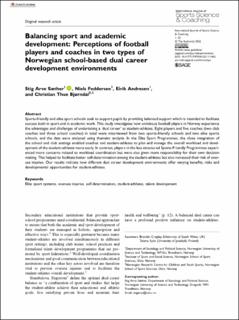| dc.contributor.author | Sæther, Stig Arve | |
| dc.contributor.author | Feddersen, Niels Boysen | |
| dc.contributor.author | Andresen, Eirik | |
| dc.contributor.author | Bjørndal, Christian Thue | |
| dc.date.accessioned | 2022-09-14T07:12:18Z | |
| dc.date.available | 2022-09-14T07:12:18Z | |
| dc.date.created | 2022-07-15T09:14:26Z | |
| dc.date.issued | 2022 | |
| dc.identifier.citation | International Journal of Sports Science & Coaching. 2022, Artikkel 17479541221111462. | en_US |
| dc.identifier.issn | 1747-9541 | |
| dc.identifier.uri | https://hdl.handle.net/11250/3017672 | |
| dc.description | This article is distributed under the terms of the Creative Commons Attribution-NonCommercial 4.0 License (https://creativecommons.org/licenses/by-nc/4.0/) which permits non-commercial use, reproduction and distribution of the work without further permission provided the original work is attributed as specified on the SAGE and Open Access page (https://us.sagepub.com/en-us/nam/open-access-at-sage). | en_US |
| dc.description.abstract | Sports-friendly and elite sport schools seek to support pupils by providing balanced support which is intended to facilitate success both in sport and in academic work. This study investigates how ambitious football players in Norway experience the advantages and challenges of undertaking a ‘dual career’ as student-athletes. Eight players and five coaches (two club coaches and three school coaches) in total were interviewed from two sports-friendly schools and two elite sports schools, and the data were analysed using thematic analysis. In the Elite Sport Programmes, the close integration of the school and club settings enabled coaches and student-athletes to plan and manage the overall workload and development of the student-athletes more easily. In contrast, players in the less structured Sports-Friendly Programmes experienced more concerns related to workload coordination but were also given more responsibility for their own decision making. This helped to facilitate better self-determination among the student-athletes but also increased their risk of overuse injuries. Our results indicate how different dual career development environments offer varying benefits, risks and developmental opportunities for student-athletes. | en_US |
| dc.language.iso | eng | en_US |
| dc.relation.uri | https://journals.sagepub.com/doi/10.1177/17479541221111462 | |
| dc.subject | elite sport systems | en_US |
| dc.subject | overuse injuries | en_US |
| dc.subject | self-determination | en_US |
| dc.subject | student-athletes | en_US |
| dc.subject | talent development | en_US |
| dc.title | Balancing sport and academic development: Perceptions of football players and coaches in two types of Norwegian school-based dual career development environments | en_US |
| dc.type | Peer reviewed | en_US |
| dc.type | Journal article | en_US |
| dc.description.version | publishedVersion | en_US |
| dc.rights.holder | © The Author(s) 2022 | en_US |
| dc.source.pagenumber | 13 | en_US |
| dc.source.journal | International Journal of Sports Science & Coaching | en_US |
| dc.identifier.doi | 10.1177/17479541221111462 | |
| dc.identifier.cristin | 2038393 | |
| dc.description.localcode | Institutt for idrett og samfunnsvitenskap / Department of Sport and Social Sciences | en_US |
| dc.source.articlenumber | 17479541221111462 | en_US |
| cristin.ispublished | true | |
| cristin.fulltext | original | |
| cristin.qualitycode | 1 | |
